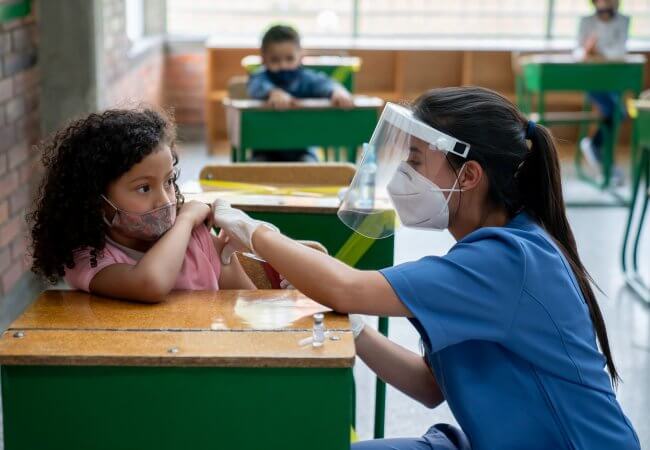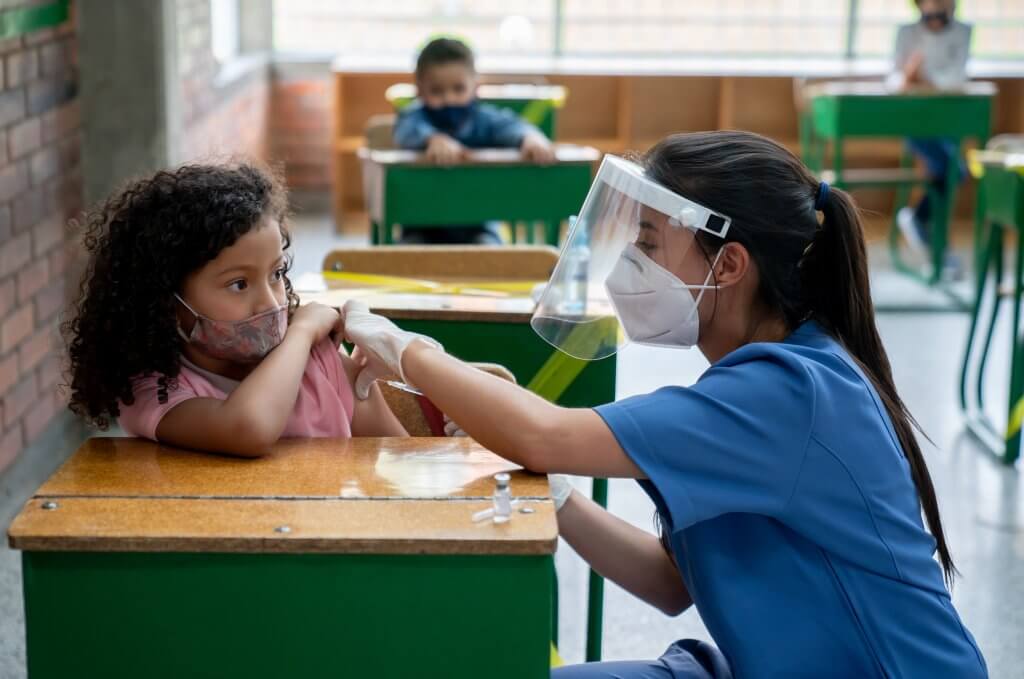
Dec 07, 2021
Advancing the Science of School Nursing through Research, Innovation and Capacity Building

Did you have a school nurse in your school growing up? What do you remember them doing? You may not realize the critical role school nurses play for all children, not just those with chronic conditions. Science has evolved and we now better understand how inequities, social factors and adverse childhood events (ACES) impact a students’ health for life. Even before COVID, over a third of the visits to the school nurses’ office were related to mental health needs, including stress and anxiety. Those numbers have since skyrocketed. School nurses may be the only consistent health professional that a student encounters.
School nurses are key in noticing trends and preventing outbreaks
Today’s school nurse uses sharpened assessment and critical thinking skills, along with leadership skills to work with both individual students and the entire school population. School nurses coordinate care and provide teaching to help students manage health conditions, as well as address sickness. They also promote health for the entire school, while advocating to improve social factors that influence students’ health. School nurses are the frontline of both public health and primary care. Their role is crucial in identifying health inequities and supporting students most at risk. School nurses notice trends early and can be key in preventing not just infectious outbreaks but behavioral trends such as substance use.
Barriers to advancing school nursing practice
The recent Future of Nursing Report 2030 highlights the importance of school nursing in our nation’s health. Yet, research related to the role and infrastructure of school nursing is sparse. I recently presented at a brown bag at the National Institute of Nursing Research at the National Institutes of Health and shared with them current research priorities and barriers to advancing school nursing practice.
School nursing research is in its infancy. In order to move it forward, we need targeted, coordinated efforts that address foundational questions:
- What school nurse interventions make the greatest impact on student health and academics outcomes?
- What do educators and other decision-makers believe are successful outcomes for students related to health?
- What staffing models allow school nurses to make the greatest impact?
- How can school nurses identify students at risk for inequities earlier?
Coordinated national surveillance system needed
Many of these answers could be investigated if there was a coordinated national surveillance system. The COVID pandemic has shown that a national, coordinated data surveillance tracking is lacking. A national system that could track not only outbreaks such as measles and COVID, but also track other emerging health concerns and the effectiveness of specific school health interventions could be a continuous benefit in better understanding student health needs. In addition to a surveillance system, we greatly need a network of districts willing to participate in research that advances our understanding of school-age children’s health and the impact of school nursing. Research related to innovative and technological solutions and the collective impact of all the components of school health are also crucial. The National Association of School Nurses (NASN) has created specific areas to be researched, and they can be found here.
Why the research isn’t further along
You may wonder with such basic needs, why the research isn’t further along. One of the challenges is a lack of funding for prevention and population-based interventions. Random controlled trials, which are seen as the gold standard for research, are not usually feasible in school settings. Many doctoral nursing programs do not teach the research methods best utilized in school nursing research. Validated measuring tools used in other healthcare settings do not frequently translate well to the school setting. Projects are often conducted in one school or setting so the participant size is low and may not be generalizable. Although much research is done in schools, it is often conducted by researchers who do not understand the school health system and tend to focus on topics, not on the infrastructure and existing staffing. This also makes the research not really transferable to practice. The delivery models of school health need empirical exploration.
Efforts are underway to create lasting change
Even with these barriers, efforts are underway to create lasting change. As the former director of research at NASN, I oversaw the development of Every Student Counts! which provides a common definition for data points so school nurses collect data the same way. Along with an advisory group, I created a research trajectory, which helps prioritize research needs and is the basis for NASN’s research priorities. Yet, more targeted activities are needed.
The Center for School Health Innovation and Quality
Recently, myself and several school nurse researchers created The Center for School Health Innovation & Quality (the Center) in order to focus on the major gaps in school nursing science. Through an environmental scan we discovered no organization exists that is devoted to the health of the whole school-age population or the specialty of school health research. The goal of the Center, once funded, is to focus on moving school nursing research forward by convening policy and school health researchers to identify existing gaps and draft a road map for how to move the science forward in order to change policy. We plan to develop a school health research institute to provide training on appropriate research methodologies for schools, as well as promote emerging research and innovative practices, and share best practices for school nursing delivery and policy improvement. The Center will focus not just on research but on quality, innovation, and building capacity to implement change into practice. We will develop indicators to measure the impact of school health programs, along with key interventions that impact those measures, and create a hub for researchers to work together on creating valid tools for school health. The Center will also convene stakeholders to reimagine a school health that integrates a data-driven, evidence-based approach to meeting student health needs. Finally, the Center will provide technical assistance, training and mentorship to new school nurse researchers, school nurse leaders and school nurses so that emerging evidence can be implemented into practice. Ultimately, the Center will drive innovation in school health research and leadership to create system-level changes so students in every community gain the tools needed to thrive in school and live healthy lives. That is the right of every student.

Maughan is executive director of the Center for School Health Innovation & Quality.
